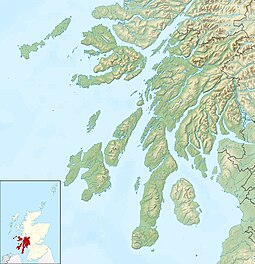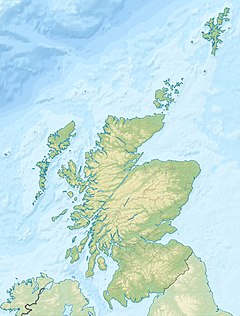Sanda Island
| Gaelic name | Sandaigh/?Abhainn |
|---|---|
| Norse name | Sandey/Havn |
| Meaning of name | Sandy Island (Norse) |
| Location | |
|
Sanda Island shown within Argyll and Bute
|
|
| OS grid reference | NR730043 |
| Coordinates | 55°17′N 5°35′W / 55.28°N 5.58°W |
| Physical geography | |
| Island group | Firth of Clyde |
| Area | 127 hectares (0.49 sq mi) |
| Area rank | 131 |
| Highest elevation | 123 metres (404 ft) |
| Administration | |
| Sovereign state | United Kingdom |
| Country | Scotland |
| Council area | Argyll and Bute |
| References | |

Sanda lighthouse, nicknamed "the Ship"
|
|
|
Scotland
|
|
| Location | Sanda Island Mull of Kintyre Argyll and Bute Scotland United Kingdom |
|---|---|
| Coordinates | 55°16′29″N 5°34′58″W / 55.274821°N 5.582836°W |
| Year first constructed | 1850 |
| Construction | masonry tower |
| Tower shape | cylindrical tower with balcony and lantern attached to 1-storey keeper’s house |
| Markings / pattern | white tower, black lantern, ochre trim |
| Height | 15 metres (49 ft) |
| Focal height | 50 metres (160 ft) |
| Light source | mains power |
| Range | 15 nautical miles (28 km; 17 mi) |
| Characteristic | Fl W 10s. |
| Admiralty number | A4274 |
| NGA number | 4248 |
| ARLHS number | SCO-301 |
| Managing agent |
Northern Lighthouse Board |
Sanda (Scottish Gaelic: Sandaigh) is a small privately owned island in Argyll and Bute, Scotland, off the southern tip of the Kintyre peninsula, near Southend and Dunaverty Castle.
On clear days Sanda can be seen from the southern tip of the Kintyre peninsula, from the Isle of Arran and from northeast County Antrim. It is known locally on Arran as "Spoon Island" because of its resemblance to an upturned spoon when viewed from the South coast of the island.
In the 2001 census, Sanda was one of four Scottish islands with a population of one person. However, since then there has been some development, and in 2008 the island had a population of 3. In August 2008 the island was put up for sale by the husband and wife owners as a result of their separation at a price of £3.2 million, and in January 2009 they announced that a sole caretaker would be resident until spring viewings re-commenced. The island was eventually sold to Swiss businessman Michi Meier for the reduced price of £2.5 million. The island's growth as a tourist destination may come to an end under the new owner who has stated that he wants the island for personal use. By the time of the 2011 census, it had no usual residents.
The island is designated a Site of Special Scientific Interest for its importance for both migrating and breeding birds. Sanda Bird Observatory was the first bird observatory to be set up on the west coast of Scotland.
The island is currently treeless, however, Wood Hill in the north west provides a tantalising clue that this was not always the case.
According to Haswell-Smith, the island's geology is "lower old red sandstone in red and yellow varieties, and undifferentiated schists."
Sanda lies in the Straits of Moyle (Scottish Gaelic: Sruth na Maoile) between Scotland and Ireland. It is part of a mini-archipelago to the southeast of the Mull of Kintyre, at the far end of the Firth of Clyde. The other islands are Glunimore and Sheep Island, to the north east. Located on the north shore of Sanda is the Oitir Buidhe (yellow sand spit), a pronounced area of sand exposed at low tide, that has two slipways. To the east there is also the notorious "ship catcher", Paterson's Reef.
...
Wikipedia


